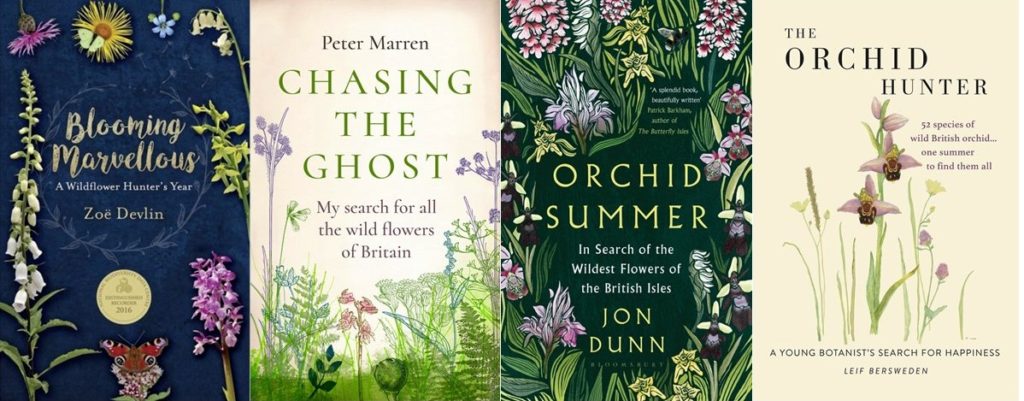Dr M first encountered Leif Bersweden on the twittersphere, as you do these days, and with his regular attractive botanical tweets on orchids and other native British plants @LeifBersweden is certainly one to follow. The first real life encounter however, was at the BSBI Annual Exhibition Meeting at the Natural History Museum in November 2017 where Leif was signing copies of his new and enthralling botanical book on his quest to find all the orchids of Britain in one season “The Orchid Hunter“. Though clearly fascinated by orchids as so many are, Leif is much more than just an orchid man as you can find out in Leif’s own words below!
I am Leif Bersweden, I’m 24 and I’m a PhD student at Kew. I wrote a book about orchids, but really I’m just a botanist with a mildly obsessive interest in Britain’s native plants!
I got into botany when I was still in primary school. I remember finding a bee orchid on the ramparts at Figsbury Ring in Wiltshire aged seven and was completely taken by it. As a teenager I went on trips with the Wiltshire Botanical Society, a fantastic group of very friendly botanists who helped nurture my interest. These were wonderful days out where age didn’t make a difference: we were all there because we loved plants.
- 7 year old Leif botanising with Dad
- Leif’s favourite plant the Bee Orchid (Ophrys apifera)
- Leif Bersweden today
I studied botany in my spare time (usually before doing my homework rather than after!) and taught myself how to identify the plants I found in the fields and woods around Winterslow where I grew up. My undergraduate degree is in biology and I’m now doing a botanical PhD.
I have worked with plants as long as I can remember. I’ve been a botanist for 17 years; whether I’m leading plant identification courses or extracting DNA in the lab, I’m completely in my element!
My research area is currently focused on orchid genetics. I’m working on a group of four orchids called man orchid (Orchis anthropophora), lady orchid (O. purpurea), military orchid (O. militaris) and monkey orchid (O. simia), found in England and across mainland Europe. They’re referred to as being anthropomorphic because each one has flowers that look like little human figures – they’ve got arms and legs. At first glance they look easily distinguishable, but when these species grow together they reproduce with one another. These inter-species partnerships result in intermediate offspring called hybrids that look half like one of the parental orchid species, and half like the other. These hybrids are generally fertile, so they are able to reproduce with each other and with both of their parents, resulting in the build-up of large populations of hybrid orchids; some will be perfect intermediates, some will look more like parent A and some will look more like parent B. My PhD is basically this: I’m trying to work out why these four orchids remain as separate species, rather than merging into one big hybrid super-species, despite the flow of genes and DNA sequences between them, via the hybrids. I’m using new DNA sequencing techniques to tease apart relationships among these species and to characterize patterns of hybridization. The things I find out will hopefully lead to greater understanding of species coherence in this group, improved understanding of hybridization and better-informed conservation management.
Some of Leif’s gorgeous orchid images (l to r) Lady, Bee, Military, Lizard and Monkey! (click on images for a closer view and Latin names).
The biggest challenge for botany today is getting the general public interested in these green things called plants! Fortunately, things look like they might be improving: on social media people are getting involved with @WildflowerHour and spreading enthusiasm for wild plants, and a flurry of recent nature writing about British and Irish plants has culminated in the publication of at least four books about native plants (see below).
My favourite plant is the bee orchid (Ophrys apifera). It’s a really cool species that evolved to exploit the sexual desire of male bees to ensure pollination. While it now pollinates itself, the flower’s resemblance to a bee is a delight to behold; it’s a beautiful plant and never ceases to intrigue me.
My botanical superhero would have to be Dom Price, though he wouldn’t describe himself as such. Dom is the Director of The Species Recovery Trust, a brilliant charity aiming to save some of our rarest wildlife from the brink of extinction. I met him 8 years ago while I was volunteering at Plantlife. We co-wrote Winter Trees and he helped get me started with teaching courses. Without Dom I wouldn’t be able to identify grasses to save my life, but thanks to him I’m now teaching other people about them! I can’t answer this one without mentioning my Mum though – she taught me my first plants and I’ll always be so grateful for that!
My web presence is primarily on Twitter where you can follow me @LeifBersweden. I also have a small website (www.leifbersweden.com) but please don’t laugh at it…!
Dr M says: Check out Leif’s podcast on @wildflowerhour here and check out these brand new British Botany Books:
Blooming Marvellous: a Wildflower Hunter’s Year by Zoë Devlin
Chasing the Ghost by Peter Marren
Orchid Summer by Jon Dunn
The Orchid Hunter by Leif Bersweden










